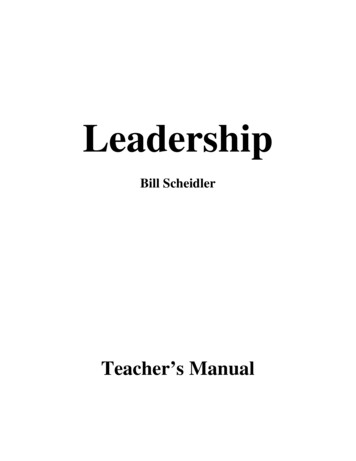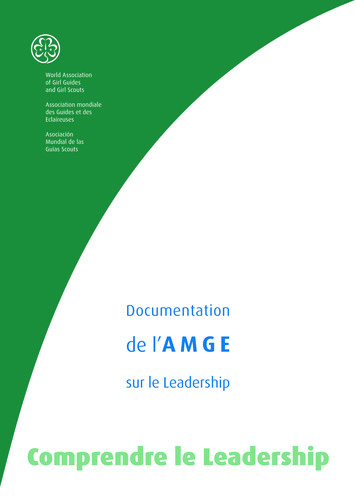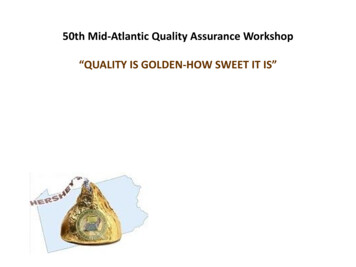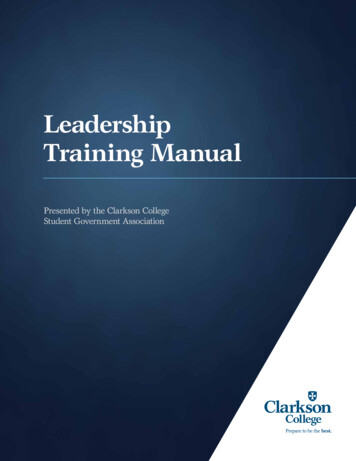
Transcription
Proceedings of the International Conference on Industrial Engineering and Operations ManagementParis, France, July 26-27, 2018The Influence of Leadership on Innovation: a Case Study inthe Telecommunications Industry in South AfricaPascalis Adams, Hannelie Nel and Annlizé MarnewickPostgraduate School of Engineering ManagementFaculty of Engineering and the Built EnvironmentUniversity of JohannesburgAuckland Park, Johannesburg, South Africapascalisadams@gmail.com, hannelien@uj.ac.za, amarnewick@uj.ac.zaAbstractLeadership is the engine of an organisation and innovation is recognised as a critical success factor for anorganisation’s survival. Leadership is at the core of creating an innovative culture within an organisation,and employees play a vital role in the execution of innovative outputs. The purpose of this research was toexamine the relationship between leadership and employee innovation and to provide an inventory ofleadership behaviours that promote innovation at an individual and organisational level. Throughexamining literature, the research will present a list of characteristics and values that are required tocultivate and promote innovation. These characteristics were studied by means of a case study in atelecommunications organisation to establish whether the organisation embraces innovative behaviour.The scope of the literature review examined the different leadership characteristics required at theindividual, group, and organisational level. Data in the case study was collected by means of aquestionnaire and analysed to provide recommendations to the organisation on ways to improve thecultivation of innovation within their workforce.KeywordsCreativity, Innovation, Leadership, Organisation1. IntroductionLeadership is the engine of an organisation and innovation is recognised as a critical success factor for anorganisation’s survival. Leadership is at the core of creating an innovative culture within organisations andemployees play a vital role in the execution of innovation. Innovation is a process that can be managed and thisencourages organizational leadership in that managers can plan, control, and organise all aspects of innovation topositively influence the outcome. Therefore, it is important to understand how leadership as a discipline affectsinnovation; and consequently, how a leader’s behaviour affects innovative behaviour within the company workforce.Since the implementation of Black Economic Empowerment (BEE) in South Africa, diversity and transformation inthe workplace have made considerable progress given that the country has undergone significant changes inmanagement and leadership within a relatively short time. A lack of business acumen, entrepreneurial drive,management skills and education, together with low technology savviness, resistance to change and a lack ofleadership affect an organization’s work processes (Safavi and Tweddell, 1990; Hall and Sandelands, 2009; Olawaleand Garwe, 2010). Despite these challenges, innovative methods remained and are still an effective solution forleaders in society (Yan, Maladzhi and Makinde, 2012). As with any paradigm shift, South African leaders needednot only to implement new approaches and techniques, but also novel ways of thinking.Anticipating the need for change leads to success in organisations, and this is achieved with minimal effort with afocus on improving outcomes (Agbor, 2008). These organisations are driven by leaders who constantly andeffectively communicate the vision and strategy of the organisation, and where everyone in the organisation sharesin the set of beliefs about why the strategy and vision are important (Pearce and Manz, 2009). Successful leaders IEOM Society International675
Proceedings of the International Conference on Industrial Engineering and Operations ManagementParis, France, July 26-27, 2018identify the need for transformational change and provide a balance between innovation and self-control to takecautious risk.This paper aims to highlight which leadership characteristics cultivate and promote innovation within a company atthe organisational and individual level, and to determine through case study if these characteristics are beingimplemented by the organisation. Through determining which characteristics influence innovation, organisationswill be able to apply these findings to promote an innovative culture in a company. Furthermore, it will assist leadersto understand which behavioural characteristics are needed to stimulate innovative thinking within the organisation.The paper starts with a literature review compiling an inventory of individual and organisational characteristicsaffecting the implementation of innovation within an organisation. A description of the case study follows toestablish if the identified characteristics are being implemented within the telecommunications industry; and thepaper concludes with recommendations at an individual and organizational level.2. Literature ReviewThe rate of globalisation is increasing rapidly as idea generation, new knowledge and global diffusion increases.Creativity and innovation have a big role to play in organizational survival in the twenty-first century (Martins andTerblanche, 2003; Armstrong, 2007). To remain relevant and sustainable within this highly competitive economicenvironment, businesses must invest in creativity and innovation. To accomplish an outcome such as creativity andinnovation, considerable devotion should be directed towards how employees perceive their organisation’sleadership (Khalili, 2016).In the 21st century, the creative process which ultimately drives innovation depends on an appropriate leadershipstyle (Martins and Terblanche, 2003; Emam, 2015). Innovation is a company-wide objective, but employees cannotinnovate unless the organisation’s leadership empowers them to do so, whilst creating an atmosphere that rewardsand values their contribution (France, Mott and Wagner, 2007). Workforce creativity and innovation can only beachieved if there is competent and effective leadership in the workplace (West and Sacramento, 2012); and it isimportant to understand what drives an organisation towards innovation. Leadership is one of the central factors thatinfluences innovation, since it can develop an organisation’s capacity to innovate and is also responsible formanaging the company culture. The latter is achieved through granting autonomy for innovative activities, and bychallenging employees towards implementing new ideas and processes (Choon-Sik, Woowon and Joongwha, 2007).Flynn and Chatman (2001) classify innovation into three genres, namely: individual, group, and system innovation(Flynn and Chatman, 2001). On an individual level the key determinants for innovation include commitment,learning and personality. At a group level, the key determinants are determined by the team’s attributes, namely size,diversity, stability, principles, leadership and communication. Organisational structure and corporate culture formpart of the system level determinants (Szczepańska-Woszczyna, 2015). Creative people are highly motivated peoplewho develop their knowledge in their field of occupation or interest. These individuals are not necessarily genius oradaptors. Creative people do not follow the status quo – they implement unconventional ways of thinking andproblem solving (Bulens, Kreitner and Kinicki, 2002). Group creativity is driven by a cohesive culture that supportsteamwork, collaboration and diversity. Organisational creativity and innovation are supported through the efficientutilisation of resources and the execution of strategy, all led by an effective leadership structure (Bulens et al., 2002).According to Martins and Terblanche (2003), leadership is one of the dimensions that describe the culture of anorganisation, together with strategy, structure, support mechanisms, behaviours that encourage innovation, andcommunication (ibid.). Figure 1 provides a graphical representation of these determinants, and each determinant isbriefly expanded below.Strategy: Leadership plays a role in creating a company-wide innovation strategy that will encourage thedevelopment and implementation of new products, procedures and services (Iya, 2015).Structure: A leadership style that allows for freedom, flexibility and teamwork will promote creativity andinnovation within the organization (Martins and Terblanche, 2003). IEOM Society International676
Proceedings of the International Conference on Industrial Engineering and Operations ManagementParis, France, July 26-27, 2018Figure 1. Leadership determinants that influence creativity and innovation (Martins and Terblanche, 2003:70)Support mechanism: Support mechanisms must be established in the workplace to create an environment thatencourages creativity and innovation (Iya, 2015).Behaviour that encourages innovation: Creativity and innovation manifest from values and norms that stem fromspecific behavioural characteristics that promote such behaviour (De-Jong and Hartog, 2007; Iya, 2015).Communication: Leaders who promote transparency that is built on trust have a positive effect on influencingcreativity and innovation (Martins and Terblanche, 2003; Yidong, 2012).Investigating the relationship between leadership and innovation in a developing country’s context is important asthese organisations often face macroeconomic volatility, intense competition and institutional instability (Tybout,2000; Farashahi and Hafsi, 2009). For an organisation to deliver unmatched creative and innovative results,management must provide demonstrable and appropriate leadership (Andriopoulos, 2001; Jung, Wu and Chow,2008; Michaelis, Stegmaier and Sonntag, 2010). Managers who understand how their leadership style affectsinnovation are more likely to cultivate innovative behaviour within their organisation (Reiter-Palman and Illies,2004). Industry leaders in the 21st century need to recognize their role in this new economic age, where their abilityto generate, exploit, and distribute knowledge, has become of utmost importance in creating wealth and gaining acompetitive firm advantage. The researchers identified the most consensual characteristics obtained from theliterature review and illustrate the twelve characteristics required by leaders to cultivate and promote innovativebehaviour within their workforce in Table 1.Leadership styles can be classified in any of the following genres, viz. result oriented; autocratic leadership;employee oriented; transactional leadership; democratic leadership; and transformational leadership (Senior andFleming, 2006). According to Samad (2012), leadership styles are based on four paradigms including classical, IEOM Society International677
Proceedings of the International Conference on Industrial Engineering and Operations ManagementParis, France, July 26-27, 2018transformational, organic and transactional (Samad, 2012). Classical leadership is based on a leader’s behaviouraland emotional reaction to decision making. Transactional leadership is where the leader manages their employees’tasks. Transformational leadership is categorised by a leader’s inspirational motivation, individualised consideration,and charisma. This kind of leader inspires followers to be committed and responsible in achieving the goal at hand.The role of transformational leaders is to inspire and motivate employees to go beyond their current perceivedabilities. The last paradigm is organic leadership, which is built on teamwork and collaboration with no roledifferentiation between employee and employer (Samad, 2012).Table 1. Leadership characteristics required to promote innovative 7.InnovativeRole-Modelling8.Recognition andRewardSupport gVisionDescriptionThey motivate followers to perform and go beyond their perceived expectations, allowingthem to achieve supreme work objectives. These kind of leaders instil respect, faith, pride, andcommunicate a mission and vision to their followers (De-Jong and Hartog, 2007; Iya, 2015).This kind of leader influences employees through motivation, loyalty, admiration, inspiration,respect, and by fostering a collective sense of mission. This leader pays attention to thedevelopmental needs of their followers, in ways that stimulate their learning experience (DeJong and Hartog, 2007; Cheung and Wong, 2011).This leader provides psychological arousal and verbal persuasion to develop followers’ selfefficacy. This allows followers to be motivated to generate novel ideas and to solve problems(Ryan and Tipu, 2013).The leader uses emotion to appeal to their followers. They provide inspiration andencouragement during the process of idea generation, allowing followers to willingly expresstheir novel ideas (De-Jong and Hartog, 2007).These leaders challenge employees to think differently by viewing old problems from a newperspective. They encourage followers to question old assumptions, challenge the status quo,and realize their curiosity (Cheung and Wong, 2011; Iya, 2015).This is a power sharing process, where the leader allows a subordinate autonomy in the way inwhich they conduct their tasks and responsibilities, thus empowering followers to willinglyfulfil and deliver on their responsibilities (Samad, 2012).These leaders inspire their followers to adopt creative and innovative behaviour. Leaders playan important role in promoting innovative behaviour through championing creativity andinnovation (Cheung and Wong, 2011; Samad, 2012).This type of behaviour involves showing appreciation and giving praise to others for theirachievements and innovative initiatives (De-Jong and Hartog, 2007).This refers to the way a leader behaves towards creativity and innovation in the workplace.This includes a variety of behaviours that support innovation within the workplace namely:acceptance, consideration, empathy, friendliness, and patience (Garacia-Morales, 2012).Leaders who provide feedback, improve the possibility of effective implementation, thuscontributing to employee innovation. Employees are enthusiastic towards expressing theircreative behaviour when their leaders provide timeous feedback (Akkermans, 2011).This leader promotes and encourages employee participation in decision making. Consultationencourages employees to generate novel ideas, and is a necessary task required before coworkers can make suggestions or implement improvements (De-Jong and Hartog, 2007).By providing a vision, leaders can communicate their ambitions and organisational objectivesto their employees. This enables followers to channel their efforts towards innovativebehaviour (Samad, 2012; Ryan and Tipu, 2013).Not all leadership styles are conducive to the cultivation of creativity and innovation. Successful companies haveshown that collaborative and shared leadership is best suited if leaders want to unlock the complete innovativepotential of their organisation - rather than an autocratic and hierarchical leadership style (Askenas, Ulrich, Jick andKerr, 2002). Organisations operating with an autocratic and hierarchal modus-operandi where higher ladderexecutives control the information, allocation of manpower, work, and decision making – produces a workforce thatis less creative, less empowered, less proactive and less productive (Hornstein and Guerre, 2006; Agbor, 2008). Thisleadership approach has minimal chance of cultivating innovation within an organisation. IEOM Society International678
Proceedings of the International Conference on Industrial Engineering and Operations ManagementParis, France, July 26-27, 2018The alternative to this is a leadership style that inspires, motivates, empowers, and coaches its staff (Yan, Maladzhiand Makinde, 2012; Maladzhi and Yan, 2014). These leaders know that in-order for the organisation to survive, allindividuals who come with various skill sets and tools, will transform the organisation towards an innovative culture.Therefore, an organisation can only become fully innovative if all its members are participants and ambassadors forleadership (Realin, 2003; Yan, Maladzhi and Makinde, 2012).3. Research MethodologyTo investigate the characteristics a leader requires to cultivate innovative behaviour within their organisation,research and an in-depth understanding of the relationship between leadership and innovation are required. A casestudy approach was selected to enable the researchers to acquire comprehensive primary data directly from theparticipants in the case. A quantitative methodology was utilised and the value thereof is that the approach hasdirect and immediate relevance to managers since it addresses issues that they see as important through quantifyingemployees’ attitudes towards the organisation (Saunders, Lewis and Thornhill, 2009). Data was collected by aquestionnaire that was administered through an online platform.The researchers structured the questionnaire to ensure consistency and relevance of questions posed to the samplegroup. The sampling group was chosen in a deliberate manner – this yielded the most relevant and reliable results.The sample group comprised 111 individuals from an engineering and operations environment in a Pay Televisioncompany operating in South Africa and Africa. The data collected was subjected to quantitative analysis to respondto the research questions. The researchers analysed the data by means of quantifying similar responses, allowing theresearchers to deduce valid and relevant conclusions from the findings.4. ResultsFrom the 111 selected participants, only 47 responded to the questionnaires equating to a response rate of 42%which was deemed sufficient for reliable and valid data analysis. The respondents were asked to answer eachquestion employing a five-point Likert scale.4.1 Feedback on Organisational PerspectivesThis section provides the results from all 47 participants regarding the organisation’s ability to innovate and theresults are provided in Figure 2.Figure 2. Cumulative ratings for questions 1 - 31 IEOM Society International679
Proceedings of the International Conference on Industrial Engineering and Operations ManagementParis, France, July 26-27, 2018The feedback indicates that there are three organisational characteristics that score a frequency rating of 70% andhigher, namely, vision and mission, flexibility, and competitiveness. There are four characteristics that are between60% and 70%, namely, empowerment, collaboration, recognition and rewards, and the availability of resources. Thecharacteristics that receive the lowest frequency rating are cooperative teams and risk taking with a cumulativepercentage of 32% and 38% respectively.4.2 Feedback on Management’s PerspectiveThese responses provided the management’s perspective regarding their ability to cultivate innovation within theirteams through the implementation of the identified characteristics.Figure 3 indicates that the majority of the management team rated all the characteristics positively; the responsesfalling between the ratings of always and often. The majority of the ratings are between 80% and 90% with a meanof above 4. The characteristics to receive the highest ratings are support for innovation and consultation, eachreceiving a rating of 95%. The characteristics that received the lowest ratings are self-efficacy and intellectualstimulation with an average rating of 50% and 75% respectively.Figure 3. Ratings per characteristic for question 32 - 564.3 Feedback on Employee PerspectivesThese responses provided the employee’s perspective regarding the management team’s ability to cultivateinnovation within the team through the implementation of the identified characteristics.From Figure 4 it can be noted that the highest ratings are between 60% and 67%, with charismatic influence anddelegation being the highest rated characteristics with an average of 67% each. The characteristics to receive thelowest ratings were recognition and consultation with an average rating of 29% and 34% respectively. IEOM Society International680
Proceedings of the International Conference on Industrial Engineering and Operations ManagementParis, France, July 26-27, 2018Figure 4. Ratings per characteristic for question 57 - 815. DiscussionThe descriptive statistics are discussed in further detail below.5.1 Organisational CharacteristicsFigure 5 indicates that most of the characteristics in which the organisation underperforms lie within the categoriesof ‘Behaviours that encourage innovation’ and ‘communication’. These characteristics are centred on specificbehaviours that inhibit or promote innovation. The findings revealed the following:Continuous learning culture: the knowledge and skills of the work force are not kept up to date, which hinderscreative and innovative thinking. Employees lack inquisitiveness and communication which further hinder theinnovative process, although team work is emphasised from a managerial level. Coupled with this is the lack of ideageneration which is attributed to employees feeling that their skills and knowledge are not being utilized by theorganisation. This could be contributed to the fact that employees feel that their daily job tasks do not truly reflecttheir skill set.The findings also indicate that change is not supported and welcomed by the organisation’s management team.There is reluctance from employees of the organisation towards risk taking because of the manner in which mistakesare dealt with. The manner in which mistakes are addressed in an organisation could determine whether employeesfeel free to behave creatively and innovatively.Conflict handling was another characteristic that was poorly rated. It was found that disagreements in the workplaceare not dealt with in a constructive manner by the management team but rather left to evolve into unmanageablesituations. During decision making phases some employees feel that their ideas or viewpoints are not supportedwithin their team, and this could be due to a virtual hierarchy that is formed within a team through experience andyears of service to the organisation. Reluctance in communication in the workplace stems from a lack of trust byemployees towards their peers and the management team (Martins and Terblanche, 2003). Employees need to feelemotionally safe to act innovatively, and for this to happen trust must to be cultivated. IEOM Society International681
Proceedings of the International Conference on Industrial Engineering and Operations ManagementParis, France, July 26-27, 2018Figure 5. Leadership determinants with mean ratingsFigure 5 indicates that vision and mission, flexibility, collaboration and competitiveness are the highest ratedcharacteristics, with strategy being the highest rated category. An innovative strategy is one that encourages thedevelopment of new services and products (Robbins, 1996). According to Covey (1993) the birth of creativity andinnovation within an organisation can be found in a shared vision and mission. The vision and mission of anorganisation is customer and market orientated, with a focus on solving customer needs. The value ofpurposefulness needs to be reflected in the vision and mission of the organisation.5.2 Management vs Employee PerspectiveFigure 6 compares the results from the employee and management perspectives. The analysis provides themanagement and employee perspectives respectively, to establish consensus on which characteristics are poorlyimplemented and those that are embraced by the management team.A positive consensus was reached for charismatic influence and vision. Employees agree that their managementteam motivates them to perform and go beyond the perceived expectation, allowing them to achieve their objectives.Leaders of the organisation communicate the organisation’s vision and objectives to their employees allowing workoutputs to be aligned with company objectives. However, there was consensus that the management team lacks theability to instil self-efficacy within the workforce, which stems from a lack of verbal and psychological motivationto generate novel ideas and solve problems.In addition, there was misalignment in the responses from the management team and employees regardingconsultation, recognition and rewards, feedback and individualised influence. The majority of the management teambelieves that they consult and provide sufficient feedback to their employees. IEOM Society International682
Proceedings of the International Conference on Industrial Engineering and Operations ManagementParis, France, July 26-27, 2018Figure 6: Positive response comparisonEmployees do not believe this to be true. The majority of employees said that they are not part of the decisionmaking process and are not provided a platform to provide their input. A lack of consultation from the managementteam undermines employees’ motivation, thus depriving the creation of new ideas (De-Jong and Hartog, 2007).Recognition and rewards was another characteristic with misaligned views. This potentially stemmed from themanagement team not providing the correct recognition and rewards to its employees. Management should beconsiderate in the method of reward and recognition because employees’ perception of satisfaction may varyamongst personnel. Feedback is a reward which could enhance employee motivation. A misalignment inindividualised influence also shows that the management team does not pay due attention to the needs of theirsubordinates on an individual level.6. Recommendations6.1 Organisational LevelFreedom is one of the core values in the literature reviewed that cultivates innovation, and is manifested throughautonomy, decision making and empowerment. Consequently, it is recommended that the management teamempowers and encourages their employees to do their work with minimal supervision, and within agreed guidelinesand procedures. To build a cooperative team, the focus should be placed on the team goals, with an emphasis oneach person’s contribution to the team’s objective. All employees should be eligible for recognition and reward,regardless of the employee’s position within the organisation. Peer-to-peer recognition may include verbal praise bycolleagues in recognition of a peer’s valuable contribution.Behaviours that encourage innovation and communication traits must be the foci within the organisation. The way inwhich an organisation deals with mistakes will determine an employee feels free to act innovatively. Tolerance ofmistakes is essential in the development of a culture that promotes creativity. Through creating an atmosphere oftolerance, employees will also be able to express their creativity through risk taking.Furthermore, it is recommended that organisational focus should be placed on encouraging employees to havepersonal communication, information sharing and mentorship programs between different designation levels in theorganization, for example between senior and specialist and engineers and technicians, since this will create andmaintain a learning culture within the company. An open-door communication policy is recommended, which could IEOM Society International683
Proceedings of the International Conference on Industrial Engineering and Operations ManagementParis, France, July 26-27, 2018include open communication and collaboration amongst individuals, teams, departments and management. This maybe included in all employees’ performance ratings as a communication key measuring indicator.6.2 Individual LevelSelf-efficacy in employees may be instilled through the acknowledgment of employee accomplishments. Successfuland acknowledged experiences lead to a greater feeling of self-efficacy. The absence of consultation in theworkplace weakens an employee’s enthusiasm and denies a project from fresh and novel ideas. This can beovercome by involving employees in the decision-making process by hosting, for example, brainstorming sessions.To ensure that there is a feedback loop between senior management and employees, it is recommended thatdebriefing sessions are held between line managers and subordinates. Additional recommendations include trainingfor poor performing team members which are included as key performance indicators and followed-up to monitorprogress. Coaching and mentorship create an ideal environment for exploring new ideas and developing action planswhilst maintaining continuous support and feedback. Such action allows for leaders to have individualised influenceover subordinates, and alternatively empowers subordinates to operate beyond their current level of performance.6. ConclusionThe first research question was to identify which characteristics influence innovative behaviour in an organisation atan individual and organisational level. Through literature review the organisational characteristics that promote aninnovative culture in an organisation were identified; and it was found that creativity and innovation in anorganisation can be influenced by multiple variables. From the literature findings, it was established that there arefour organisational values that cultivate and promote innovation within an organisation, namely strategy, structure,support mechanism, behaviours that support innovation, and communication. It was established that if thesedeterminants are not supported within an organisation, innovation will not prevail. The influence of eachdeterminant on innovation was analysed through an empirical study to determine if these values are being adoptedwithin a company in the telecommunications industry.The study was limited to an organisation within the telecommunications industry in South Africa, and this presentsan opportunity to extend the research to other engineering secto
Classical leadership is based on a leader's behavioural and emotional reaction to decision making. Transactional leadership is where the leader manages their employees' tasks. Transformational leadership is categorised by a leader's inspirational motivation, individualised consideration, and charisma.











